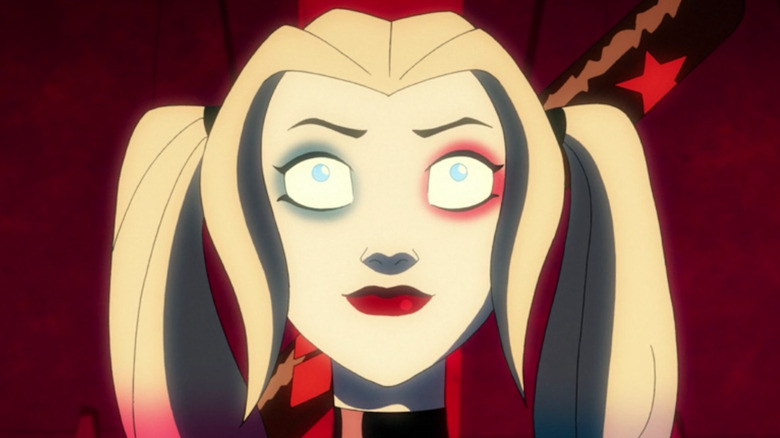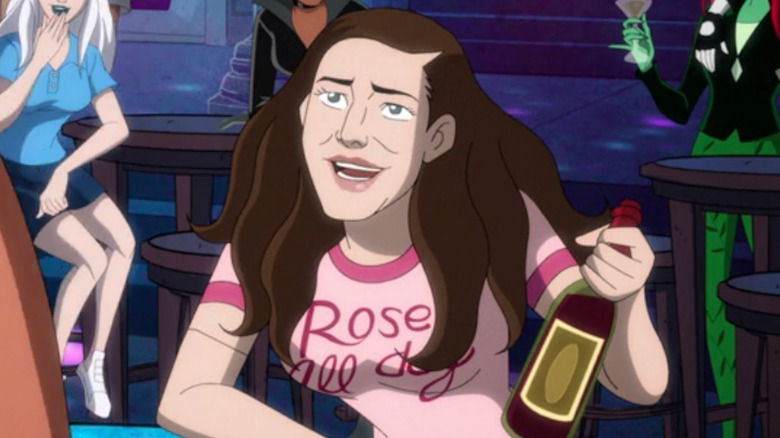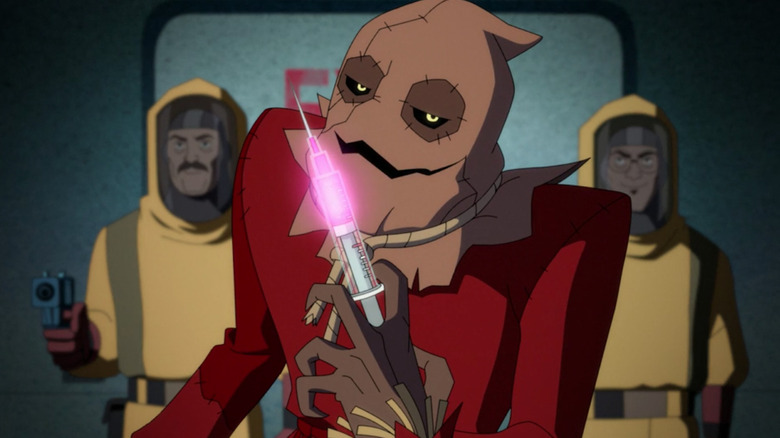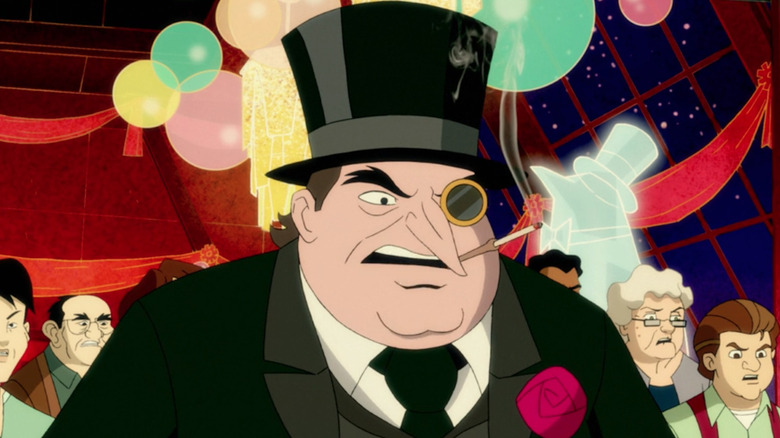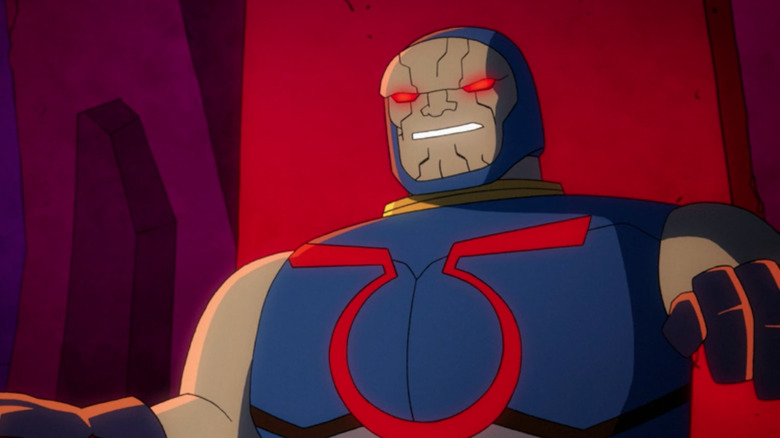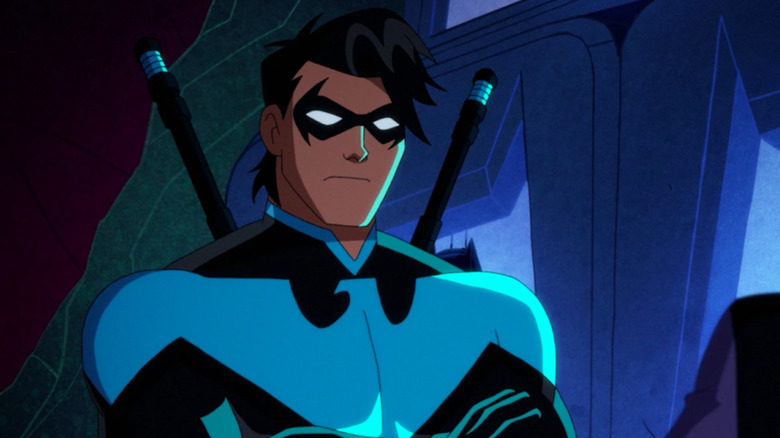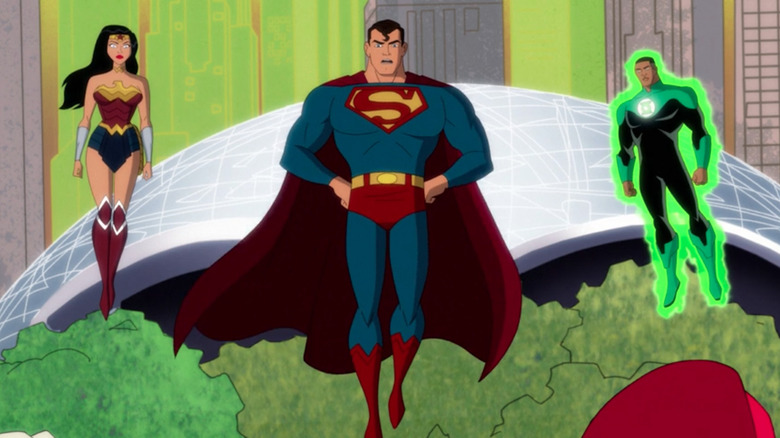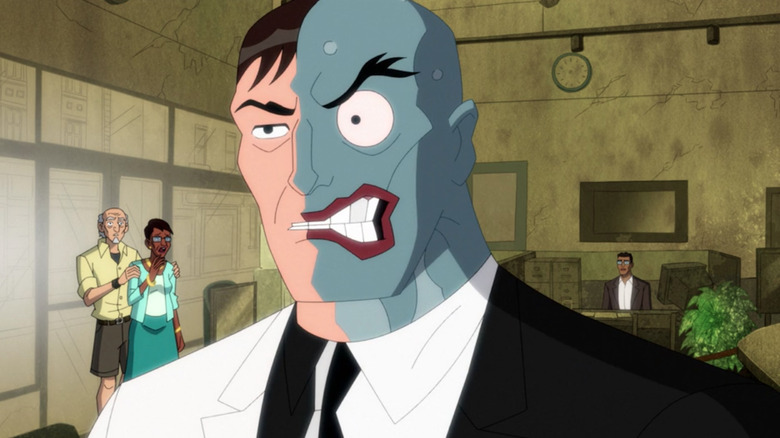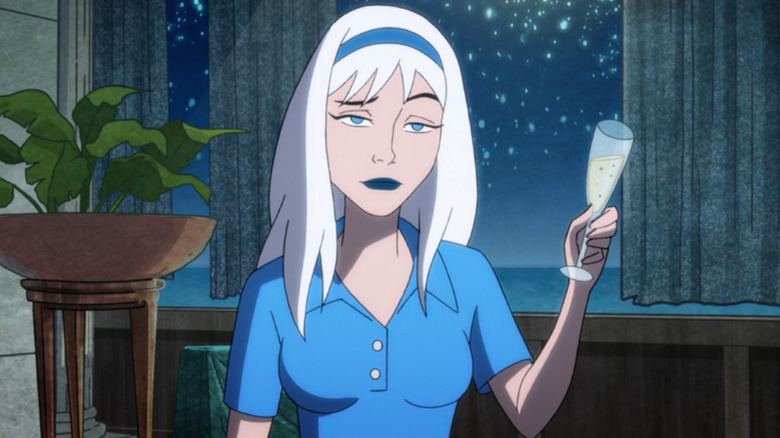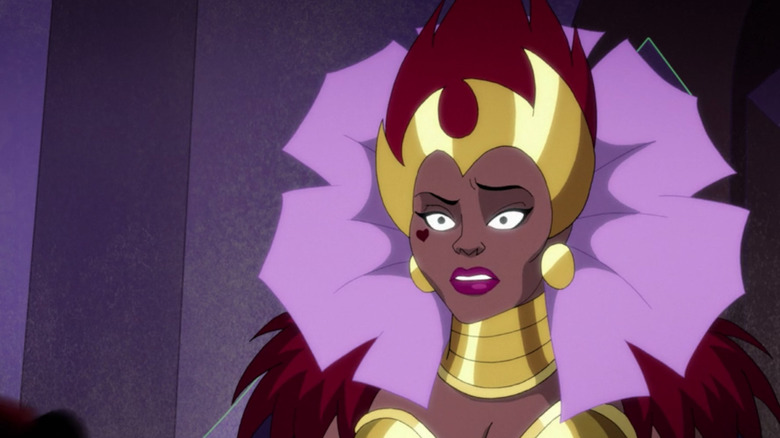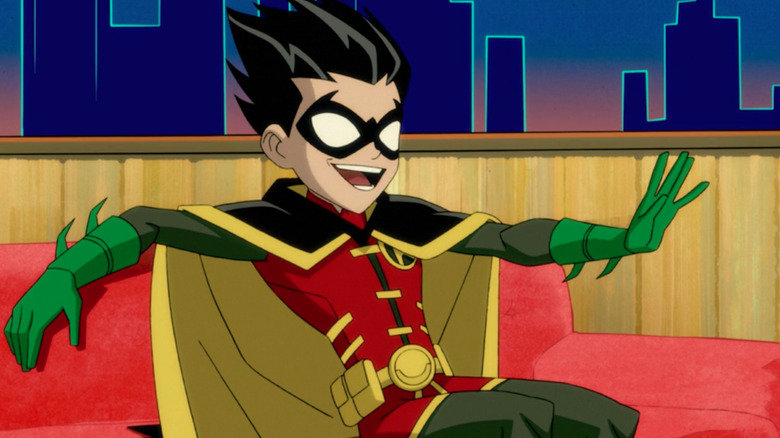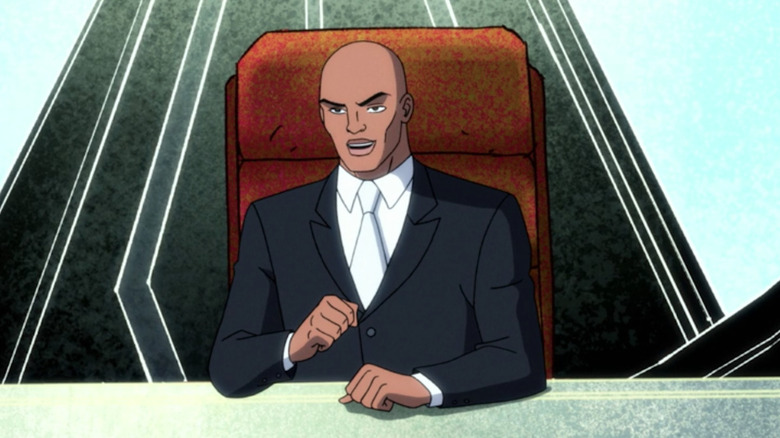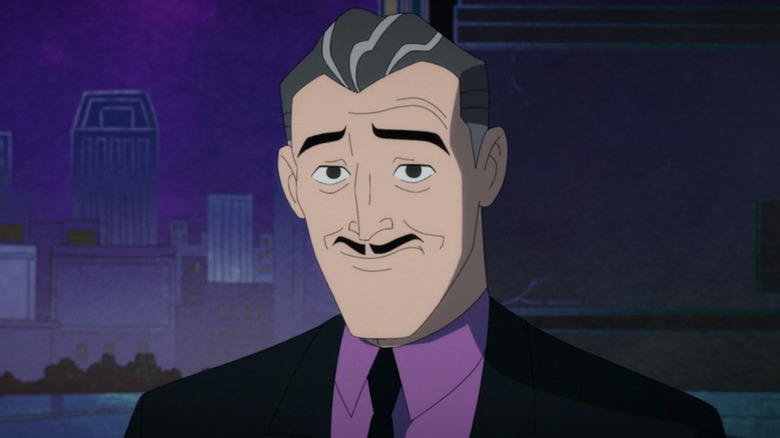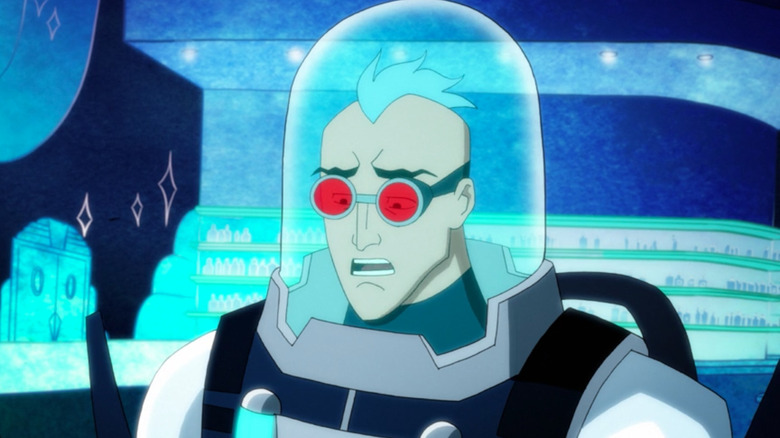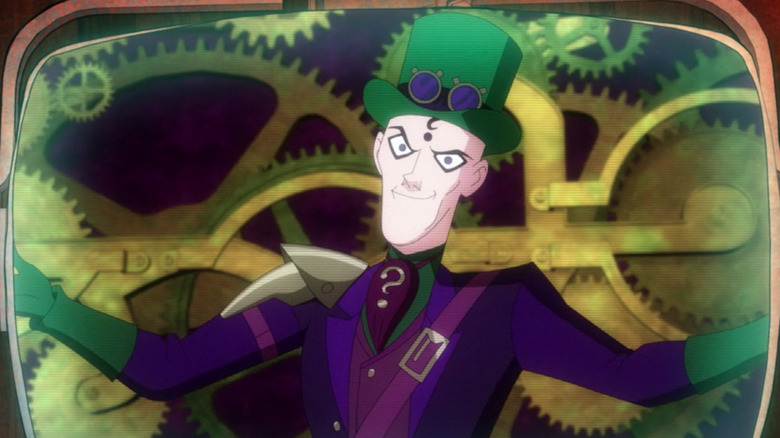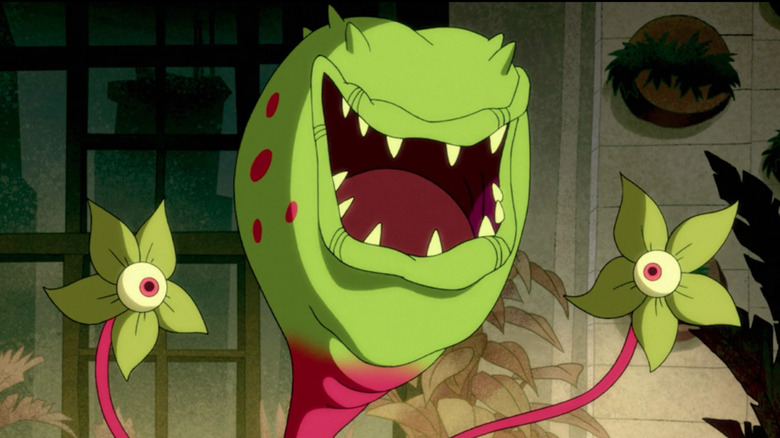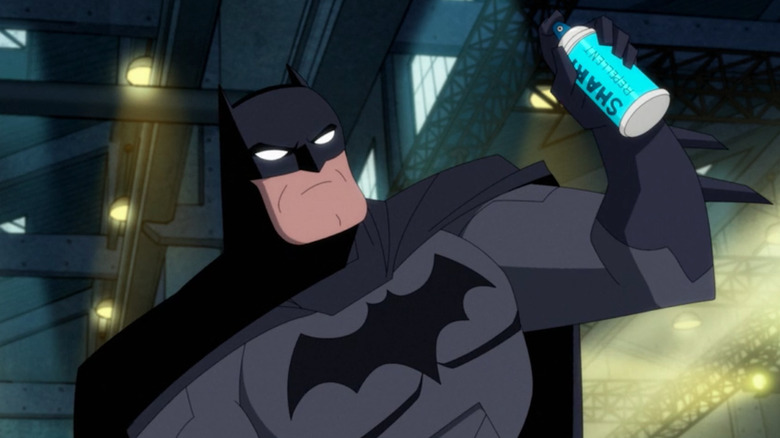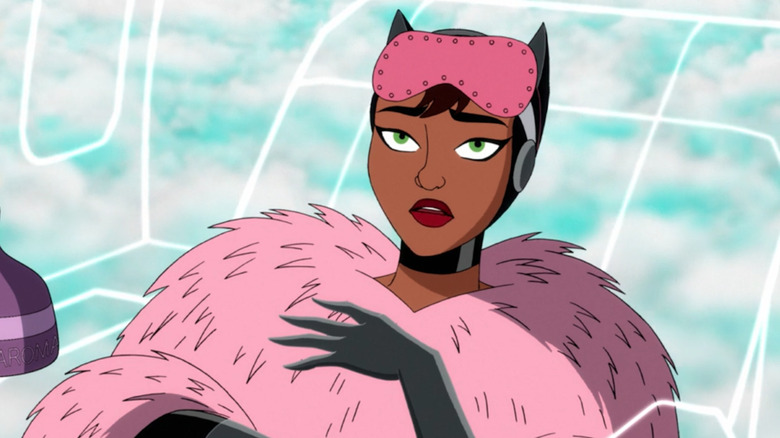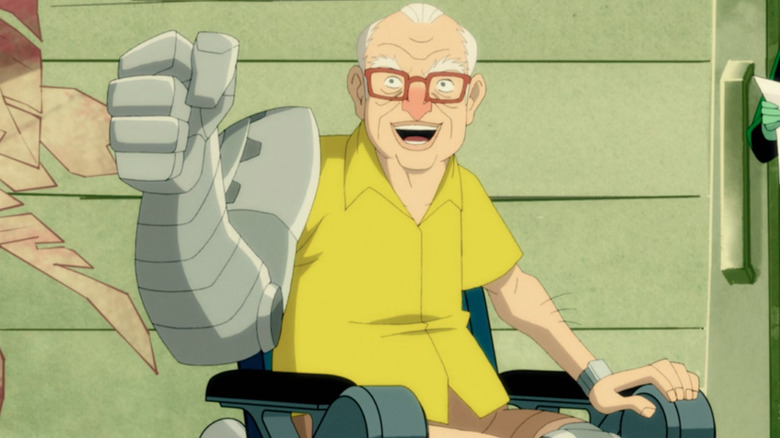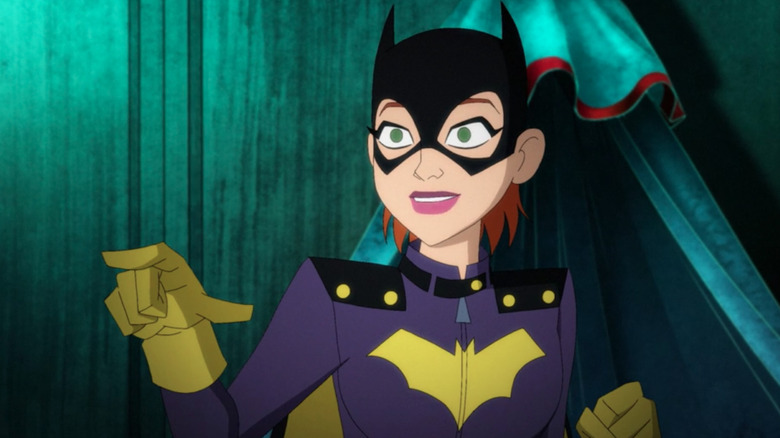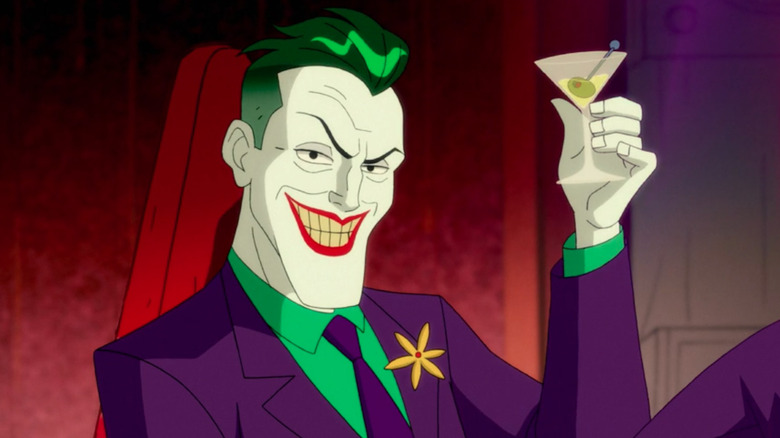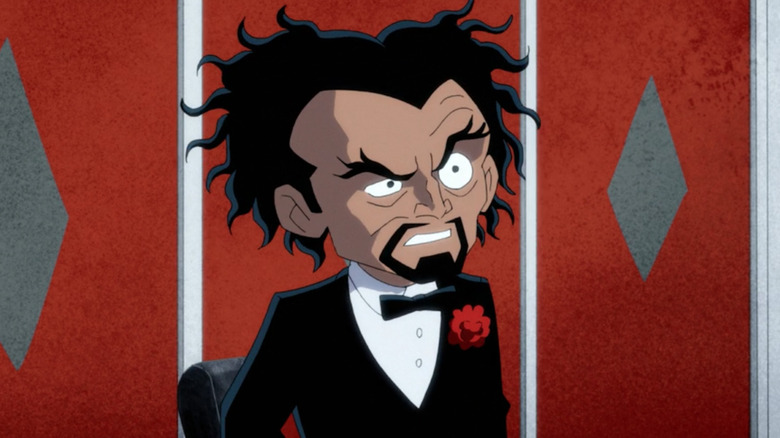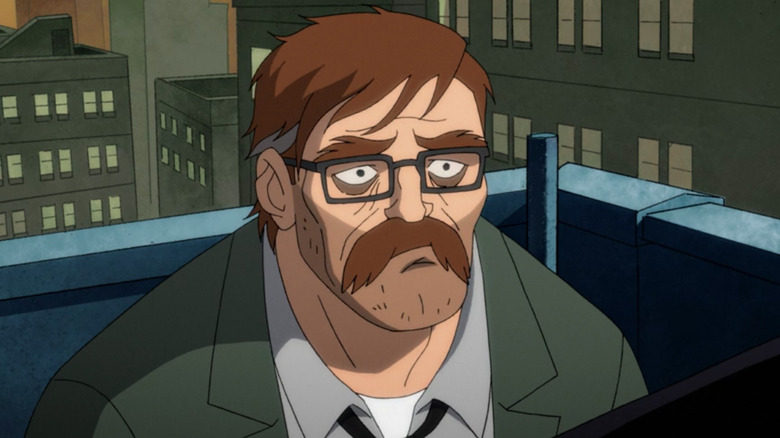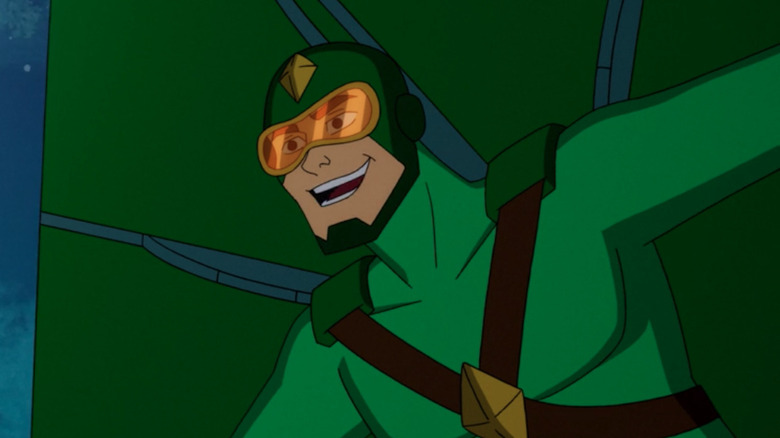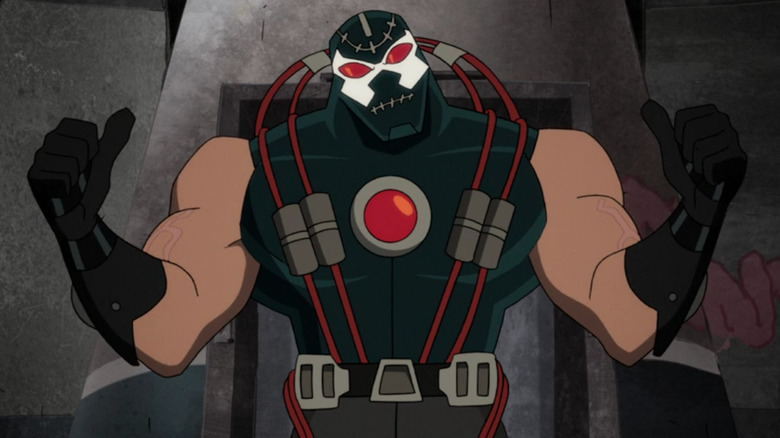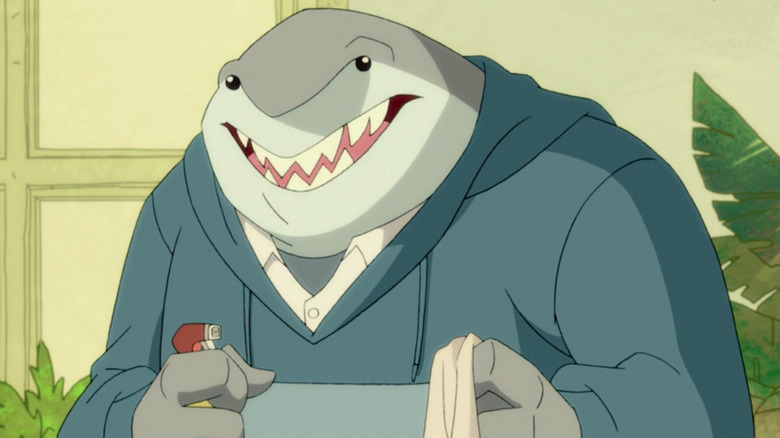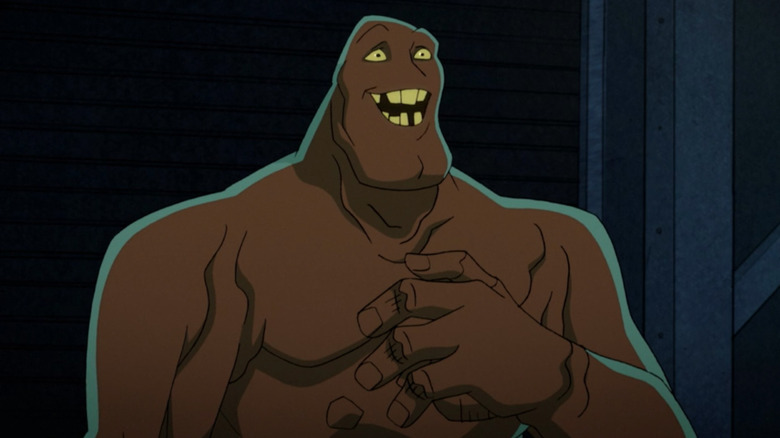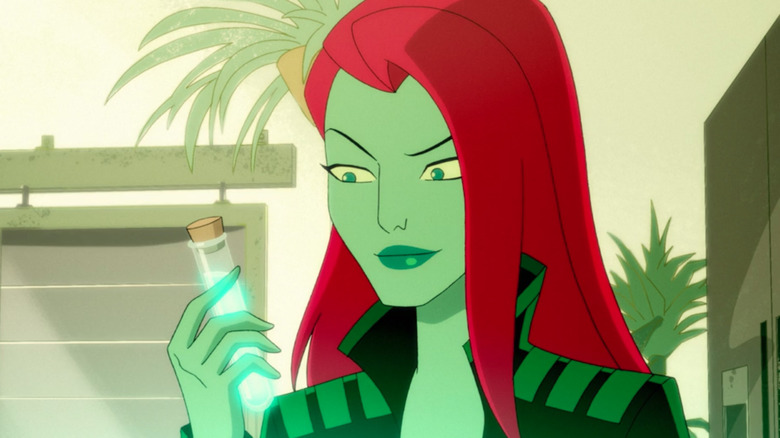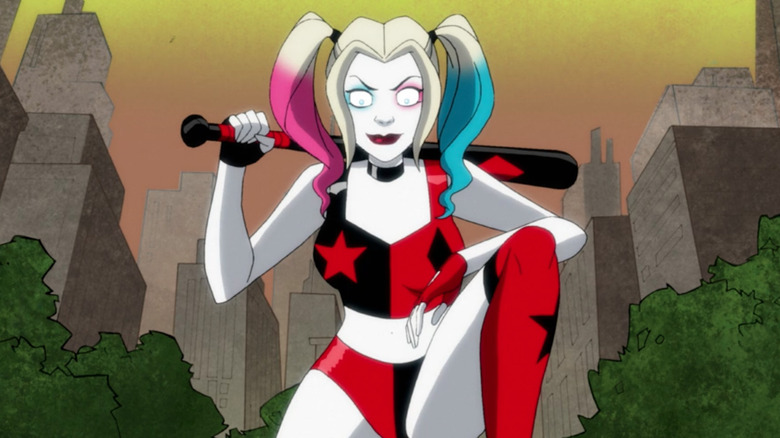Ranking Every Major Character On Harley Quinn
Few DC properties on film and television right now enjoy as much love and support as "Harley Quinn." Premiering in November of 2019 on the short-lived DC Universe streaming service (before that service was restructured and largely folded into HBO Max), the show has offered fans an animated exploration through the craziest and most obscure characters and situations that the comics have to offer. It manages to walk a tightrope between feeling very adult (through its use of bloody violence and crass language), yet never taking itself so seriously that it can't have fun at the expense of some of the world's most iconic heroes and villains. It's a semi-meta satire of the entire Bat-verse while also finding room for meaningful explorations of queer romance, gaslighting, insecurity, and the benefits of therapy.
Over the course of three seasons (with a fourth potentially on the way), the show has racked up critical accolades (per Rotten Tomatoes) while finding itself frequently beloved by fans who are relieved to find a raunchy depiction of the Bat-verse that doesn't carry over the self-important tone many of the movies tend to lean toward. Best of all, it provides a proper emancipation for the titular psychiatrist-turned-hyper-athletic clown girl, as she finds herself escaping the Joker's shadow and carving out her own identity.. But while Harley is the star of the show, there's plenty of room for the diverse ensemble to make a strong impression. Here is a ranking of every major character from "Harley Quinn." Spoilers for Seasons 1-3 follow.
28. Jennifer
An original character created for the show, Jennifer (as voiced by Mary Holland) is introduced as one of Poison Ivy's bridesmaids, the only one without any kind of supervillain affiliation. Ostensibly just a normal suburban mom, she and Ivy have been friends since kindergarten, and promised to be each other's maids of honor whenever they got married. Seeing as how Harley was taking over those duties, there was immediate resentment right out of the gate as she joined the rest of the bachelorette party on a trip to Themyscira, which had suspiciously been converted to a resort by the evil Eris. Though initially bored by the whole trip, Harley persisted in pushing them to have a good time until she finally ended up doing so.
While she's completely without powers and doesn't seem to have much interest in the fantastical world that her friend is a part of, Jennifer (don't call her Jen) shows that she has a vivacious and borderline feral side, assisting the rest of the bridal party (at this point nicknamed the "Cobb Squad") in overthrowing Eris and even throwing her from a balcony — though one senses that her rage has more to do with the resort's lack of bottomless mimosas than any concern for the environmental damage being done. She's seen again at Ivy's wedding to Kite Man, clearly upset that Harley is attempting to get involved. Though it's amusing to see her tackling Amazons, there's not much more to the character than that.
27. Scarecrow
Scarecrow is one of Batman's oldest and most consistently recurring villains, having earned a live-action appearance in "Batman Begins" (as played by Cillian Murphy) and even served as the primary antagonist of the video game "Batman: Arkham Knight." This version of the character, provided with a cockney British accent courtesy of "Midnight Mass" star Rahul Kohli, is obviously a bit less intimidating, since as with many of his fellow villains he is shown to be completely subservient to the Joker. Unlike his colleagues, however, the fear gas-administering psychopath is revealed to be an actual ally of Joker, serving as his right-hand man in a grand scheme to destroy the Legion of Doom and take over Gotham.
The former Dr. Jonathan Crane proves willing to capture and experiment on Ivy in order to grow an army of tree monsters, and even goes as far as helping to capture Batman. Unfortunately, he takes his loyalty to the Clown Prince of Crime a little too far when, observing that his boss has grown bored with torturing his nemesis, takes things a step further by unmasking him, revealing billionaire Bruce Wayne. This enrages Joker, who promptly melts Scarecrow's face with acid. His is a brief run on the show, with little humor to offer beyond a throwaway joke about insurance companies being the real villains, though he does establish early on that this continuity is willing to kill off major characters for good, no matter how popular they might be in other media.
26. Penguin
The version of Penguin seen in "Harley Quinn" is pretty standard issue relative to what has been seen in other interpretations. Not quite as grotesque as Danny DeVito's version from "Batman Returns," but a very similar look (not to mention a reference to the bloody nose-biting scene in that film, although the tables are turned here). This iteration, perfectly voiced by Wayne Knight, is more of a classy mob boss, with the major departure being that he's Jewish. (We know this because the first time we meet him is in the middle of his son's bar mitzvah.) After Harley accidentally ruins the festivities, he tries and fails to kill her, and from then on the two have a heated yet polite animosity towards one another.
This gets exacerbated in the second season, when Penguin helps to form the Injustice League in the wake of Gotham's devastation. After Harley rejects their offer, her frozen body becomes a fixture of his Iceberg Lounge, until her crew breaks her out. The ensuing battle results in the flightless bird's gory death, adding another casualty to the list of those that the show is willing to permanently kill characters without a second thought. Though he's certainly an accurate depiction of the character from the comics, this version of Penguin just doesn't get enough screen time to really rank among the best of the show's massive ensemble cast, and in many ways his son Joshua winds up with more character development.
25. Darkseid
The easiest way to describe Darkseid is that he is the DC equivalent of Marvel's Thanos, although that would be a gross simplification of this terrifying warlord. Voiced with chilling resonance by Michael Ironside (who has played the character in a number of other animated properties), the ruler of Apokolips seeks conquest above all else, frequently depicted as either hunting for or in possession of the Anti-Life Equation. The version seen in "Harley Quinn," though every bit as imposing and destructive as his comic counterpart, mostly exists as a conduit for first Harley and then a bitter Doctor Psycho to take control of his legion of parademons. He initially gives them to Harley after she proves herself in exchange for her using them to conquer Earth in his name.
Though Harley initially seems to be following through with this plan, Ivy helps her to see that this kind of mass destruction isn't really what she wants, leading her to relinquish her control of the parademons. Doctor Psycho uses a telepathic amplifier to take over, and tries to get Darkseid to honor his deal with Harley. When he is eventually defeated and Harley once again rejects the army, Darkseid admits confusion and returns to Apokolips. The character's stone-faced seriousness creates a humorous contrast with the zanier characters (as in his reaction to Doctor Psycho's backstory), but he is another character whose presence on the show is too brief to place him high on the list.
24. Nightwing
Dick Grayson, the original Boy Wonder, has grown beyond his previous identity as Robin, and has been patrolling the streets of Blüdhaven for several years as Nightwing. When he returns to Gotham at the beginning of "Harley Quinn" Season 3, we meet him as a brooding, posturing, deeply insecure young man who is reluctantly returning to his former mentor, but wants to make it clear that he's grown beyond being a mere ward. Upon arriving at the Batcave, Nightwing immediately butts heads with new teammate Batgirl, whom he views as both beneath him and also a threat to his standing within the Bat-family. Their inability to work as a team almost instantly proves to be their undoing, as the two end up tangled in each other's grappling hooks and failing to apprehend the villainous Firefly.
This is essentially a variation on Nightwing's function throughout the rest of the season: he hangs out as part of the Bat-family, but disapproves of everything (especially Batgirl and the new Robin) and constantly tries to make himself seem more impressive. He does eventually learn to be a better team member, and "What We Do in the Shadows" star Harvey Guillén imbues him with a humorous amount of intense self-seriousness. But based on his current appearances, this version of the character simply feels too one-note to really stand out among the show's outlandish roster of heroes and villains, leaving him to mostly hang out on the sidelines or assist with the action scenes.
23. The Justice League
It should go without saying that each individual member of the Justice League is more than compelling and dynamic enough to warrant their own entry in other media (Superman has of course starred in numerous live-action films, not to mention cameos and TV appearances, while Gal Gadot's take on Wonder Woman has earned significant acclaim and box office success within the DCEU). However, for the purposes of their representation within the context of "Harley Quinn," they are most often seen and considered as part of a group. There are exceptions, such as Wonder Woman's duel with Doctor Psycho that winds up getting him cancelled, Aquaman's attempt to attack the Legion of Doom, and Superman patronizing Harley by allowing Robin to rescue Lois Lane. But for the most part, the greatest heroes in the world are here frequently reduced to team-up appearances.
While some of them are still able to create amusing scenarios, such as Wonder Woman mistakenly believing that Superman can translate parademon and being called a racist, but the majority of their screen time is spent fighting a mind-controlled Poison Ivy, or mistakenly believing Harley and her crew are responsible for Joker's destructive schemes. Two members, Green Lantern and Zatanna, have yet to receive any dialogue, and at the end of Season 1 the team gets trapped in the Queen of Fables' storybook, where they spend the majority of Season 2. This leads to a version of the team that feels significantly neutered for the show.
22. Two-Face
Disgraced former District Attorney Harvey Dent turned to a life of crime after half of his face was scarred in a horrible accident, lending credence to his backstabbing nature and forever establishing him with the moniker Two-Face. As slimily portrayed by Andy Daly, this interpretation of the character doesn't seem to be nearly as troubled by a split personality or a need for fairness, at least when compared to his live-action equivalents (Tommy Lee Jones in "Batman Forever" and Aaron Eckhart in "The Dark Knight"). Though the first season of "Harley Quinn" largely sees him as yet another Batman villain and Legion of Doom member, Season 2 elevates his role in a big way, as he becomes a founding member of the Injustice League. Once Harley Quinn takes out several other members of the League and Batman seemingly returns to fight crime, Two-Face proposes a partnership with Bane, amusingly branding them as "Two Faces," which the latter complains is too much of a thinker.
After setting Harley and Gordon against each other at Ivy's wedding, Two-Face returns in Season 3 as Gordon's mayoral campaign manager, doing his best to apply his criminal practices to the world of politics despite Barbara's pushback and Gordon's incompetence. The latter's inability to grasp Two-Face's duplicitous nature is a brilliant running joke, as the former DA frequently betrays him for political rivals, before crawling back when it's convenient. Though not as outwardly comical as his peers, the character still gets more than a few laughs.
21. Nora Freeze
The wife of Victor Fries, a brilliant scientist in the field of cryogenics, Nora Fries developed a rare blood condition with no known cure that threatened to kill her. Out of options, her husband froze her in a block of ice so he could hunt for a solution, a road that eventually led him to become the supervillain Mr. Freeze. In Season 2 of "Harley Quinn," the title character's misunderstanding of the couple's relationship leads her to thaw Nora's body prematurely in the hopes of saving her, before realizing that the two are madly in love and that her disease is very real. Though Poison Ivy is able to arrive on the scene and develop a cure, it requires Mr. Freeze to sacrifice his life for hers via blood transfusion, resulting in her being saved but now a widow.
In an effort to make amends, Harley invites Nora to Ivy's bachelorette party, and although she's initially resentful of the women who killed her husband, she eventually loosens up and finds herself liberated by the whole experience, even sleeping with Maxie Zeus over the course of the girls' crazy weekend. She later returns in Season 3 and assists Harley and Ivy with tracking down and getting information from Swamp Thing. Voiced with party-girl energy by Rachel Dratch, this version of Nora is notable for being the only one who's allowed a proper character arc outside of serving as motivation for her husband.
20. Queen of Fables
A super-villainess who wields the magical power of fairy tale characters (the Big Bad Wolf, the Gingerbread Man, etc) to do her murderous bidding, the Queen of Fables is a relatively recent addition to DC Comics whose most high-profile appearance is easily on "Harley Quinn." Voiced by Wanda Sykes, she's introduced as a cautionary tale to Harley about the dangers of a female villain trying to gain too much power. Indeed, when we first meet her, she's actually imprisoned in a U.S. Tax Code manual, reduced to acting as a tax consultant as punishment by the Justice League, which she considers to be a double standard considering that all her male contemporaries would have just been sent to Arkham Asylum.
Later in Season 1, she's released from the Tax Code due to some legal mishandling of her imprisonment, and she's clearly back with a vengeance. Initially agreeing to help Harley and her crew with a job, she's quickly revealed as having no boundaries and being more than happy to slaughter an entire extended family to cover up a single witness. When Harley rejects this level of death and destruction, Fables throws her lot in with the Joker, helping him take over Gotham before ultimately being decapitated by Harley. Though her time on the series is relatively short-lived, the fact that such an obscure character is given so much prominence displays the showrunners' willingness to populate their cast with deep cuts.
19. Robin
There have been many crime-fighting youths to adopt the masked identity of Robin over the years, from Dick "Nightwing" Grayson to Jason "Red Hood" Todd to Stephanie "Spoiler" Brown, but one of the more unique to take on the mantle is Batman's own son, Damian Wayne. Typically depicted as a teen skilled beyond his years with more than a little darkness in him, the version played by Jacob Tremblay in "Harley Quinn" has far more youthfulness, though he obviously aspires to the kind of brooding intensity that comes so naturally to his father. He gets a great introduction early in Season 1 when he presents himself as a potential nemesis for Harley, who is naturally unenthusiastic about the prospect of regularly fighting a child.
After he pushes her too far by declaring their relationship status on a talk show, Harley strikes back by capturing him and threatening him with being devoured by King Shark before he accidentally reveals his true colors to a live TV audience. Though it's hilarious to see him bite off more than he can chew by taunting Harley, or drowning in Batman's costume while the former is indisposed, Robin mostly disappears into the background after making such a strong first impression. He shows up with the rest of the Bat-family throughout Season 3, and clearly has no lost love for the former Robin when Nightwing comes back to town, but otherwise he plays a mostly minor role within the larger narrative.
18. Lex Luthor
Giancarlo Esposito might be the king of playing menacing villains on TV. After exploding in popularity as drug kingpin Gus Fring in "Breaking Bad" (a role he went on to reprise in "Better Call Saul"), he's since made a strong impression as nefarious characters on shows like "The Mandalorian" and "The Boys." So in a show that primarily focuses on supervillains like "Harley Quinn," it's only natural to want to cast him as one of the biggest bad guys around. Esposito's chillingly measured delivery is perfectly suited to Superman nemesis Lex Luthor, seen here as more of a CEO type who runs the Legion of Doom. Though largely a calm and genial presence, he quickly establishes his villainous bona fides by manipulating Ivy and Harley against each other over the prospect of the latter being invited to join their organization.
Despite his intimidating vocal presence, Luthor also gets to play around with the show's comedic sensibilities, best displayed in an L.O.D. meeting where he regularly shuts down Bane's input, or when he bemoans the extended legal battle his organization is involved in. He adds a lot to the show whenever he's around, and the only reason he isn't higher on the list is because after Joker destroys the Legion headquarters, he's only briefly seen in the second two seasons, and exclusively over TV monitors. Still, Season 3 suggests that he's working toward rebuilding the L.O.D., which holds promise for the future.
17. Alfred
Bruce Wayne's longtime butler, mentor, confidante, and occasional partner in crimefighting, Alfred Pennyworth has seen many incarnations over the years, from Michael Gough's grandfatherly take in the first run of live-action films to Michael Caine's comforting presence through the "Dark Knight" trilogy, Jeremy Irons' gruffer interpretation for Zack Snyder's DC films, and Andy Serkis and Sean Pertwee's more world-weary depictions in "The Batman" and "Gotham," respectively. The version we see in "Harley Quinn," as played by Tom Hollander, is something of a blend of the various Alfreds who came before him: old enough to have a certain wisdom, yet spry enough to get in on the action when the occasion calls for it.
We see this in the form of a superhero called the Macaroni, an alter ego that sees Alfred adorned in old-timey formal attire and a giant mechanical wig with which to trounce evildoers. He finds himself in need of this persona while Bruce is in recovery during Season 2, and even uses it to come to his master's rescue when an impatient Batman tries and fails to use a more advanced suit to go up against Bane. Alfred makes a very strong impression in this episode, doling out the sarcastic quips and hard-earned life lessons that one would normally associate with the character. A shame, then, that Season 3 largely sees him in the background supporting the Bat-family in a mostly silent capacity, only cracking wise to observe Bruce's obsession with Selina Kyle.
16. Mr. Freeze
The man once known as Victor Fries has had a rather inconsistent time when it comes to adaptation in media. The version seen on the Adam West "Batman" series (played alternately by George Sanders, Otto Preminger, and Eli Wallach) was a campy bank robber type with a freeze gimmick, which was pretty par for the course on that show. In "Batman: The Animated Series," however, he was completely overhauled with a new, tragic backstory about his dying wife Nora and his desperate attempts to find her a cure ultimately turning him into a man unable to survive outside the cold. That backstory carried over into his live-action debut, as played by Arnold Schwarzenegger in "Batman & Robin," but the silly tone and garish aesthetics of that film didn't exactly endear him to fans.
In "Harley Quinn," he's much closer to the "Animated Series" interpretation, albeit with a slick new design and a slightly kooky demeanor. Though he teams up with the Injustice League in order to take control of a section of Gotham, his criminal endeavors are still motivated by his quest to save his wife. Freeze really only gets one episode to shine in Season 2, but shine he does, whether it's through his surprisingly hospitable attitude toward his prisoners (he makes them lunch and everything), his noble sacrifice in order to save his wife via blood transfusion, or the surprising warmth given to him by Alfred Molina. The iceman's time on the show is brief but memorable.
15. Riddler
Riddle me this: who's one of Batman's oldest foes, yet always open to a fresh interpretation? Why, that would be the Riddler, of course, whose previous media depictions have included Frank Gorshin's manic portrayal in the 1960s "Batman" series, Jim Carrey's deranged take in "Batman Forever," and Paul Dano's inspired performance in "The Batman." On "Harley Quinn," he's voiced by the irascible Jim Rash, and despite a number of costume changes is very faithful to what you'd expect from the character: He places his potential victims in traps and leaves them puzzles to solve, or maybe he'll plant a bomb in the city that can only be deactivated by solving one of his riddles. Classic Riddler stuff.
Where this iteration stands apart is the variety of unconventional subplots he finds himself going through. In Season 1 he assists Ivy in putting together a fake trap to help Harley understand how little Joker values her. In Season 2 he opens his own university, gets captured, and is forced to run on a giant hamster wheel until he becomes impossibly jacked (not to mention his brief team-up with Doctor Psycho once the latter turns heel and tries to destroy Gotham). And in Season 3, we discover that he's in a relationship with D-list Batman villain the Clock King, to the point where they're both hoping to win Best Couple at the 83rd Annual Villy Awards, despite their difficulty kissing with Clock King's clock face.
14. Frank the Plant
An original character for the show, Frank is a mutated Venus flytrap brought to life by Poison Ivy and given the ability to speak (in the voice of J.B. Smoove, no less) and move around on his own (within the confines of a flower pot, that is). Though not technically a part of Harley's crew, Frank is very much a series regular, as well as Ivy's roommate. That said, he's not a very good roommate, since we discover he ate the kid she hired to come water her other plants while she was away at Arkham. A wisecracking, pot-smoking, free-loving guy who loves to get involved in everyone else's drama, Frank has quickly become a fan favorite, to the point where he jokes about having "tested well" when he breaks the fourth wall as a framing device in an episode of Season 2.
In Season 3, however, he becomes an integral part of the plot, as he is captured by none other than Bruce Wayne, who reverse-engineers Frank's DNA in a misguided attempt to bring his parents back from the dead. This short-sighted plan ends up accidentally initiating an ever-so-brief zombie apocalypse, which Frank assists in dealing with. After being juiced up via Ivy's connection to a mysterious force called the Green, he starts to morph and develop powers of his own. Despite his robust screen time compared to significantly better-known characters, Frank's humor is largely limited to snarky remarks at others' expense. Funny, but occasionally grating.
13. Batman
The man. The myth. The legend. Batman needs no introduction. He's Batman. He's one of the most beloved characters in all of fiction, which has netted him over a dozen live-action film appearances, various live and animated shows dedicated to either him or other characters in his immediate vicinity, video games, merchandise, and so much more. His appearances are so numerous that Diedrich Bader, who provides that appropriately gravelly voice work for the character in "Harley Quinn," had already him played him in earlier animated properties, including all three seasons of "Batman: The Brave and the Bold." Despite having numerous interpretations over the many years he's been around, Batman is always recognizably Batman, and that consistency absolutely carries through to his recurring role in "Harley Quinn."
While not exactly a series regular, the Caped Crusader shows up prominently, and finds himself in plenty of wacky situations. Whether it's working on his relationship with Jim Gordon, recovering from crippling injuries despite being highly impatient to get back into the field, or inadvertently raising an army of the dead rather than properly dealing with the trauma of his parents' death, this version of Batman works because he maintains his stoic composure no matter how ridiculous the situation. Season 3 even ends on a note of hope for the character, as he allows himself to be arrested for tax evasion and even lets Harley help him work through his many, many mental health issues.
12. Catwoman
Gotham's favorite antihero didn't make her debut on "Harley Quinn" until the second season, but when she did arrive she came with more than her fair share of baggage. The renowned cat burglar has of course been portrayed numerous times in all manner of Batman media, most memorably by Julie Newmar in the Adam West series, Michelle Pfeiffer in "Batman Returns," and Zoë Kravitz in "The Batman." Here she's portrayed by a silk-voiced Sanaa Lathan, and is shown to have a complicated background with Poison Ivy, who simultaneously worships her free-spirited independence and is put off by her self-serving narcissism. We eventually learn that the two of them used to hook up, but when Ivy wanted more and Catwoman clearly didn't, things ended.
First appearing to help Harley and co. steal Firefly's flamethrower from Doctor Trap's highly rigged hideout in the Gotham Natural History Museum, Catwoman returns as one of Ivy's bridesmaids. Initially uninterested in the bachelorette party, she allows herself to let loose and have fun with the rest of the "Cobb Squad." In Season 3, much of her arc revolves around her relationship with Bruce Wayne, who is far too needy and clingy for someone who cherishes her freedom and doesn't like to be pinned down. Though often more smarmy and curt than outright funny, the drama that Catwoman creates for the other characters, as well as her increasingly failed attempts to keep them all from getting too close, provide ample entertainment value.
11. Sy Borgman
A former CIA operative with a shady past and no shortage of skeletons in his closet, Sy Borgman (voiced with distinctive panache by Jason Alexander) is introduced as Ivy's crotchety landlord. Though seemingly an withering old man who happens to be augmented with cybernetic implants, Sy quickly reveals himself as ruthless, merciless, and surprisingly friendly once he's allowed to become part of Harley's crew. Of course, this only happens after they catch him attempting to burn their unconscious bodies in a furnace, suggesting that this isn't the first time he's used such an approach to dispose of corpses.
The more we get to know Sy, the more we uncover just how many strange occurrences populate his increasingly mysterious backstory. Sometimes it's a beloved sister he keeps in the basement after she accidentally transforms into a horrible squid-like monster. Other times it's the fact that his body is engineered with the capacity to transform into a car if the situation calls for it. Sy is full of surprises, the biggest of which is that he sacrifices himself to help Harley and her team escape after Doctor Psycho turns on them. Though it's initially sad to see him go, it turns out he has one more trick up his sleeve: with some assistance from Kite Man, his consciousness is transferred to the internet and various electronics. He no longer plays much of a role on the series, but is still present for major events appearing on TV screens.
10. Batgirl
A prominent member of the Bat-family in most forms of media, Batgirl (aka Barbara Gordon, aka the police commissioner's daughter) may be young, but she has a fiery passion for justice and is willing to take matters into her own hands when her city starts falling apart. Versions of the character have appeared on film (as played by Alicia Silverstone in "Batman & Robin") and in games (she's one of the playable protagonists of "Gotham Knights"), not to mention dozens of animated depictions across various shows and movies. In "Harley Quinn," she's voiced by Briana Cuoco, sister of the show's executive producer and Harley voice actor Kaley Cuoco. Unlike many characters in this continuity, who mostly arrive fully formed, Barbara actually gets an origin story of sorts: she's a student at Riddler University who helps Harley and Ivy take down the nefarious dean.
This brush with crimefighting awakens something in her, and before long she's put together her own costume and is taking to the rooftops as Batgirl. Though both Batman and Gordon are initially skeptical of her abilities, she turns them both around and even helps her father take back the city from the Injustice League. Pure of heart and determined to prove herself, she is a frequently joyful presence, and her running subplots in Season 3 (about learning to work with Nightwing and getting Harley to admit that they're friends despite ostensibly being on opposite sides of the law) are a lot of fun to watch.
9. Joker
If Batman is one of the most beloved heroes of all time, then it only stands to reason that his arch-nemesis the Joker would find himself with an equal amount of popularity. The Clown Prince of Crime has appeared in nearly as many adaptations as the Caped Crusader, and is so often portrayed that two separate actors have won Academy Awards for the role (Heath Ledger in "The Dark Knight" and Joaquin Phoenix in "Joker"). With such an impressive pedigree behind the character, it would seem difficult to create a new version for the purposes of "Harley Quinn." Fortunately, thanks in large part to Alan Tudyk's sinister yet jovial vocal performance, the show proves that there's still plenty of material to mine.
The show kicks off with Harley's emancipation from their toxic relationship, and most of Season 1 deals directly with the fallout from that, building up to his plan to take over Gotham before Harley and her crew take him down. Due to some acid-based amnesia, Joker finds himself living as a suburban stepdad and a hapless bartender, an existence he finds himself enjoying so much that even after he gets his memory back, he decides to keep it going. This leads to a hilarious subplot in Season 3 where, in an attempt to provide better educational options for his stepchildren, he runs for mayor and actually wins, leaving the character in a place we've never seen him before.
8. Doctor Psycho
One of the most morally dubious characters in "Harley Quinn," a show that primarily focuses on super-villains, Doctor Psycho started out as a relatively impressive villain in his own right, earning a place at the Legion of Doom and able to even contend with Wonder Woman on his own using his telepathic abilities. Unfortunately for him, during this fight he uttered a highly offensive burst of profanity on live TV, resulting in his being canceled by the media and expelled from the L.O.D. Desperate and disgraced, he reluctantly agrees to join Harley's crew, and becomes a regular member of the core cast, aiding with various heists and even repairing his relationship with his son in the process.
In Season 2, however, after being appalled at Harley for rejecting the use of Darkseid's parademon army, Psycho joins forces with the Riddler and turns against his former teammates, using a telepathic amplifier to control both them and the army. His plans are ultimately thwarted and he's sent to Arkham Asylum, though evidently his feelings against Harley aren't so harsh that he isn't willing to help her and Ivy with some telepathy to enter Bruce Wayne's mind and locate Frank. The character's status in the overall story is now somewhat ambiguous going forward (he could stay evil, or rejoin the crew), but thanks to his snarky personality and Tony Hale's delightfully demented voice performance, he's always a pleasure to have onscreen, whether he's a part of the main crew or fighting against them.
7. Jim Gordon
One of the biggest departures in characterization that "Harley Quinn" has to offer is in Christopher Meloni's portrayal of an utterly broken Commissioner Jim Gordon. While live-action takes on the character have ranged from ineffectual and doddering (such as with Pat Hingle in the initial four-film run) to highly competent and motivated (Gary Oldman's version from the "Dark Knight" trilogy), the show depicts a man that's been doing this for so long and with so little success that he's barely able to keep it together. Unshaven, constantly clutching either a coffee mug or a beer can, and deeply insecure about his relationship with Batman, this Gordon is deeply depressed and highly temperamental.
While content to spend much of Season 1 trying to get his vigilante co-worker to hang out with him, befriending Clayface's sentient hand, and attempting to use tanks to stop an army of tree monsters, Season 2 is where the character really gets into gear. Initially despondent after the police department is scattered and the Injustice League takes over the city, discovering that his own daughter has begun fighting crime as Batgirl reawakens a fire in him, and he singlehandedly takes back the Gotham Police Department from Two-Face and his goons. Despite this, Two-Face is able to inspire him to run for Mayor, with the former DA as his campaign manager, though this ultimately flounders once the Joker steps into the race. Gordon's exhausted edginess is a frequent source of humor for the show.
6. Kite Man
There are your A-list villains, like Joker or Penguin, who are never far away from their next media adaptation. Then there are B-listers, like Bane or Mr. Freeze, who are still popular but show up less frequently. Somewhere near the very bottom of that list you'll find Kite Man, whose only "power" to speak of is a retractable kite on his back. For any other show, this would seem like far too lame of a character to include, but in "Harley Quinn," his lameness is a comedic goldmine, allowing voice actor Matt Oberg to fully tap into the blissful delusion of a man who's able to walk into a room of super-people with nothing but, well, a kite, and still feel absolute confidence in himself.
It's this inexplicable confidence that first fuels his pursuit of Poison Ivy, and against all logic she finds herself falling for his dopey charm. Their relationship goes from something she'd rather keep hidden to a full-blown engagement. While Kite Man frets about the venue being stolen by his nemesis, the equally dopey Condiment King, Ivy finds herself having second thoughts and sleeps with Harley, which throws a real spammer in the works. After realizing that she doesn't really want a life with him at their wedding, he decides to break things off, paving the way for Harley and Ivy to finally be together. Happily, Season 3 shows that he has a new girlfriend and has moved on.
5. Bane
One of the most consistently funny characters in "Harley Quinn" is an absolutely inspired depiction of Bane, the longtime antagonist who famously broke Batman's back in the comics and in "The Dark Knight Rises," where he was played by Tom Hardy to menacing effect. In the show, comedian James Adomian puts on an approximation of Hardy's distinctively whimsical speech pattern, but in service of a character that's far more goofy and accident-prone than he's ever been allowed to be in any other media. This version of Bane channels his potent anger issues into a desire to blow things up, and while he's fairly friendly to his villainous counterparts, they have little more than scorn for him.
Indeed, even though he's a founding member of the Injustice League, his colleagues insist that he sit on a tiny folding chair rather than the comfortable ones they're all using. He still does what he can to do right by his fellow villains, such as when he gets control of an underground prison in Season 2, and uses it to get the inmates under his watch to focus their issues on arts and crafts projects. After Ivy and Kite Man's wedding falls apart, Season 3 sees Bane consumed with getting back the expensive pasta maker he'd gotten them as a gift. This eventually pushes him to seek out therapy to work on his problems, though despite being in a healthier place he still can't get any respect from his peers.
4. King Shark
Another massive departure in characterization comes in the form of King Shark, as cheerfully embodied by comedian Ron Funches in "Harley Quinn." While other media typically depicts the humanoid shark monster as a simpleton with a taste for human flesh (see the version voiced by Sylvester Stallone in "The Suicide Squad"), this iteration of the character is a kind-hearted computer geek who ambles around in a hoodie and cargo pants, and ends up joining Harley's crew for the friendship and because he like to be on a schedule. A far cry from the carnivorous monstrosity one might expect, although this version isn't above eating a few heads if the job calls for it.
Also known as Nanaue in the undersea kingdom he abandoned to live his own life, King ingratiated himself with the main cast early on, and has been part of all their major adventures across the run of the show. He'll occasionally return home to his kingdom to deal with some family drama, whether it be an arranged marriage set up by his controlling father, or a plot by his brother Prince Shark to sell out their land to the villainous Ocean Master. Though he is a formidable physical force and a tech wiz, the greatest strength King brings to the table is good vibes, as he is frequently the one to hand out free compliments and rebuff the nastier attitudes projected by some of his less well-adjusted compatriots, making him a thoroughly pleasant presence throughout.
3. Clayface
Though there have been versions of Clayface in the comics, video games, and animated series that started out as an actor before being transformed into a shape-shifting mud creature, none have taken on a commitment to the craft quite like the one we see in "Harley Quinn." Bolstered by Alan Tudyk's deliciously hammy line readings, this Clayface is a true thespian to his core, and although he does possess the ability to become a giant or make weapons with his arms, his primary contribution to Harley's team is his ability to disguise himself as a variety of characters, usually with way too many background details and epic pronunciations to be fully believable.
Among the most loyal and dedicated of the main crew, Clayface's true passion will always be for performance, and more than once he's found himself getting far too invested in a character (such as a ditzy college student he portrays at Riddler University, who becomes far more enamored with co-ed gossip than with anything relating to their undercover plan). His yearning for acting peaks in Season 3 when he finds himself on the set of a James Gunn-directed Thomas Wayne biopic, and has to take over for leading man Billy Bob Thornton after inadvertently killing him. This leads to a crisis of confidence at the film's premiere, as the deceased star earns the lion's share of praise from the audience, despite Clayface's attempts to reveal himself as the actor behind the actor, which does not sit well with him.
2. Poison Ivy
Among Batman's most formidable adversaries, Poison Ivy's specific brand of eco-terrorism and supernatural ability to control plant life have made her a significant threat to many a hero over the years. While the version of Ivy we see in "Harley Quinn" is absolutely capable of untold devastation (and is frequently forced to unleash these powers by nefarious agents), she's also battling her own insecurities and loneliness. She'll openly admit that plants like Frank were her only real friends before Harley stepped into her life like the big ball of chaos that she is. Lake Bell does an excellent job navigating Ivy's journey towards accepting herself and others, first by allowing herself to be part of a group of friends, then by opening up her heart.
Outside of her powers being manipulated by Scarecrow and Psycho, her main through-line in the first two seasons is her evolving relationship with Kite Man, which she finds herself rushed into when he proposes to her multiple times. Around this time, feelings start to blossom between her and best friend Harley, which only complicates things. Eventually they throw caution to the wind and allow themselves to be together, with Season 3 focusing on them finding a good balance between their commitment to each other and Ivy's reignited desire to cover the world in plant life. One of the more emotionally complex characters on the show, Ivy alternates between being a voice of reason and the source of drama, always remaining an engaging presence.
1. Harley Quinn
It wouldn't be a great look if Harley Quinn herself wasn't able to take the top spot in a ranking of characters on the "Harley Quinn" show, but this is still far from a gimme. The character was introduced in "Batman: The Animated Series" as female sidekick to the Joker, and evolved through various comic, movie, and game appearances to be more of a proper love interest. The problem eventually arose that their romance, while great for couples cosplay, was deeply toxic and unhealthy. As Harley herself began to rival the popularity of her Puddin', a narrative shift across all media began to occur, allowing her to split up with the mad clown and to establish herself as a noteworthy villain in her own right.
This is the entire thrust of "Harley Quinn," and though there was initial skepticism about "Big Bang Theory" star Kaley Cuoco taking over the voice work that Arleen Sorkin had made famous, she has proven more than capable by leaning into the complexity and vulnerability that comes with such a chaotic character learning to better understand herself. Harley's impulsiveness, her half-baked schemes, her loyalty to her friends, and her insatiable desire for respect all drive the show forward, and by the end it's impossible to say that this version of the iconic villainess hasn't completely redefined herself, both in the context of the show's narrative and within the pop culture landscape as a whole.
